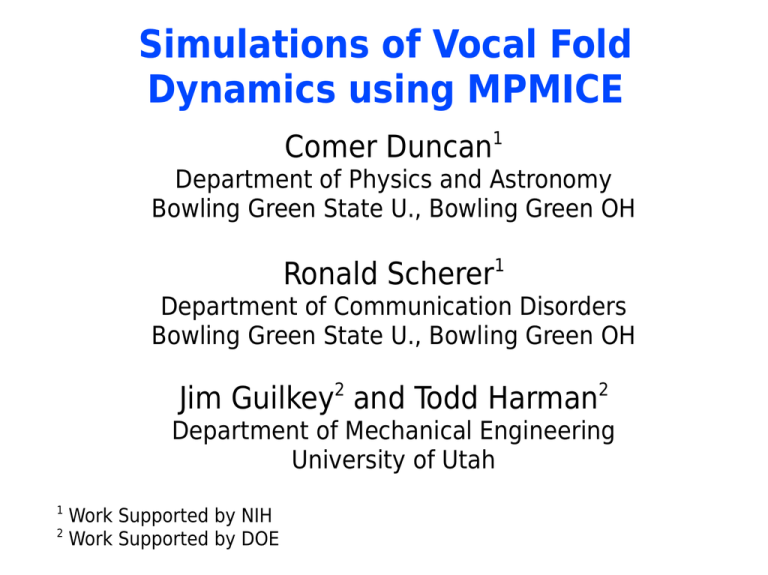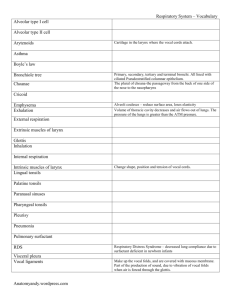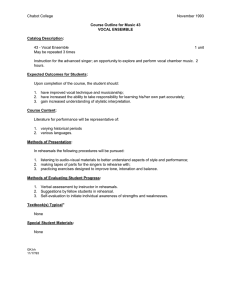Simulations of Vocal Fold Dynamics using MPMICE Comer Duncan Ronald Scherer
advertisement

Simulations of Vocal Fold Dynamics using MPMICE Comer Duncan1 Department of Physics and Astronomy Bowling Green State U., Bowling Green OH Ronald Scherer1 Department of Communication Disorders Bowling Green State U., Bowling Green OH Jim Guilkey2 and Todd Harman2 Department of Mechanical Engineering University of Utah 1 Work Supported by NIH 2 Work Supported by DOE Outline ● ● Basics of the structure of the larynx and the mechanism for the production of sound Brief outline of MPMICE in relation to the vocal fold and aerodynamics problem ● Preliminary vocal fold material model ● Example simulations for Psubglottal=Patm+ 800 Pa ● Current developments How does phonation occur? Phonation ● Occurs in the the larynx at the level of the vocal folds Phonation ● ● Occurs in the vocal folds in the larynx A stream of air with sufficient transglottal pressure induces the vocal folds to vibrate ~130 Hz for males & ~260 Hz for females Phonation ● ● ● Occurs in the vocal folds in the larynx A stream of air with sufficient transglottal pressure induces the vocal folds to vibrate ~130 Hz for males & ~260 Hz for females Sound shaped by pharynx, nasal & oral cavities Basic overview of vocal fold dynamics ● ● ● ● Lungs supply pressure of 1500 Pa above atmospheric pressure Air flows through glottis inducing vocal folds to separate via positive pressure Vocal fold material properties react to bring vf back toward initial state Result is a 'pulse' of air which flows toward mouth A Complete Vibration Cycle ● ● ● ● VF begin closed(1) Pressure gradient induces lower part to open first (2-4) VF material reacts back to closure (5-8) Note phased opening and closing P ≃ 800 Pa Coronal slice across vf Vocal Fold-Aerodynamics Modeling ● ● ● ● ● Air flow exerts force on the vocal folds (vf) which are displaced Material properties of vocal folds act back to restore the vf to their initial positions Both the air flow and the vf material dynamics are interdependent The physiological response is emergent The problem is thus a type of Fluid-Structure Interaction problem Multifield Approach to FSI ● ● ● ● Averaged model which allows both air and vf to exist at any point of space with some probability-developed by Bucky Kashiwa et al at LANL, uses MPM for material modeling -developed by Sulsky et al and ICE for air Strong interactions between the air and the vf materials (so N=2 here) Full Navier-Stokes for air and transient nonlinear response of the vocal fold material State vector for r-material ⟨ M r ,ur , er , T r , vr ,r , r ,p ⟩ State of each material ● Mr mass of r-material ● ur velocity of r-material ● er internal energy per unit mass of r-material ● Tr temperature of r-material ● vr volume per unit mass of r-material ● ● ● r volume fraction of r-material r Stress of r-material P equilibrium pressure Basic Equations of Multifield Model of FSI 1 Dr M r V Dt 0 = Conservation of Mass N 1 Dr M r ur = r ∇⋅∇⋅r r − ∑ f rs V Dt s=1 Conservation of Momentum where = −p I mean stress and f rs = K rs r s ur −u s N ∑ r =1 s=1 momentum exchange force N ⇒ 0=1− ∑ r vr s=1 Solved to obtain equilibrium pressure Basic Equations of Multifield Model of FSI (cont'd) Dr vr 1 D r M r er = −r p r r : ∇ ur −∇⋅j r V Dt Dt where and and j r = −r br ∇ T r qrs = H rs r s T r −T s r N ∑ qrs s=1 Heat flux current Internal energy exchange rate is the deviatoric part of stress N D T Ds T s 1 Dr M r v r r r = f r ∇⋅ur r − f r ∑ s s V Dt Dt Dt s=1 N where Conservation of Energy u= ∑ s u s s=1 mean velocity and f r = Evolution of Specific Volume r r N ∑ s s s=1 A simplified one-material model showing geometry of vocal folds ● ● ● A simplified coronal slice Left and right vf are made of same material Particles are used to characterize the vocal fold material Material model ● Particles with spatially varying material properties ● ● ● Current simulations use Neo-Hook Initial particle distribution taken from standard coronal slice of mid-plane vocal fold Allows flexibility in material properties specification to more readily match histology Sketch of Coronal Slice ● ● A step in the modeling is to abstract some simplified structures Complete generality given up so that a computer model can be realistically devised. Three Layer Model: relation to histology ● ● ● Outermost layer = Mucosa: consists of the epithelium and the superficial layer of the lamina propria Middle layer = Ligament: consists of the intermediate and deep layers of the lamina propria Innermost layer = Deep layer: consists of the thyroarytenoid (vocalis) muscle Example three-layer model ● ● ● ● 2D (z thickness small), each layer neo-hook mucosa, ligament, & muscle Variable shear modulus for each layer Same constant bulk modulus for all layers K=289 kPa Gmucosa =10 kPa; Gligament=30 kPa; Gmuscle=3.5 kPa Example Simulations ICE: MPM: ● time integration: explicit ● interpolator: GIMP ● do grid reset: true ● ● ● Advection: 2nd order ● Pressure solve: implicit ● Neo-hook with modification to map color to shear modulus in initial data set, constant bulk modulus ● Total particles: 11989 ● BC at inlet: Dirichlet pressure, Neumann for velocity, temp, and density BC at outlet: LODI for pressure, velocity, temp, density Resolution: 87 x 320 Movies ● ● 1. Close-up of the vocal folds with a graph of both the pressure and the opening width between the vocal folds as a function of time distribution of materials in distinct layers ● ● 2. movie showing the whole computational domain with vf and aerodynamics distribution of materials continuously varying Current Developments ● ● ● ● Use nonlinear material models, since experiments show that materials are not neoHookean--materials are hyperelastic transverse isotropic Improve outflow boundary condition treatment Extract pressure signal at outflow Move to 3D ! Thanks !






